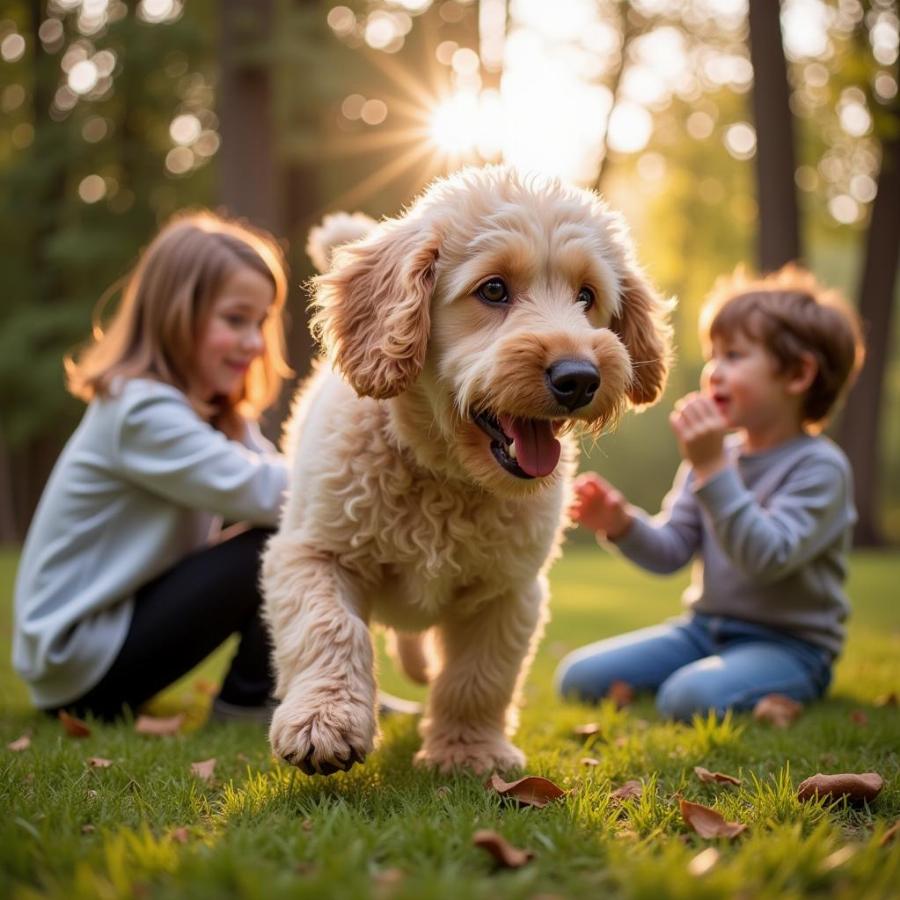Curly eared dogs capture hearts with their unique and often whimsical appearance. But beyond their adorable ears, these breeds offer a diverse range of personalities, sizes, and care requirements. This comprehensive guide will delve into the world of curly eared dog breeds, helping you understand their unique characteristics and determine which one might be the perfect fit for your lifestyle. We’ll also cover essential care tips to ensure your curly-eared companion thrives.
Understanding the Charm of Curly Eared Dogs
What exactly makes a curly eared dog so appealing? Is it the playful bounce of their ears as they run? Or perhaps the way their curls frame their expressive faces? For many, it’s the combination of these charming physical traits coupled with the distinct personalities often found in these breeds. From the energetic Bedlington Terrier to the loyal Portuguese Podengo Pequeno, curly eared dogs offer a wide spectrum of temperaments and energy levels. Choosing the right breed requires careful consideration of your lifestyle, living situation, and experience with dogs.
Popular Curly Eared Dog Breeds
Several breeds are known for their distinctive curly ears. Here’s a closer look at some of the most popular:
- Bedlington Terrier: These dogs have a distinct lamb-like appearance, with tightly curled fur and characteristically arched backs. They’re known for their playful and affectionate nature, but they also have a strong prey drive and require consistent training.
- Pumi: The Pumi is a Hungarian herding breed with corkscrew-like curls and a lively, intelligent personality. They are highly trainable and excel in dog sports like agility and obedience.
- Portuguese Podengo Pequeno: This small breed comes in both smooth and wire-haired varieties, with the wire-haired version sporting a dense, curly coat. They are known for their independent nature and strong hunting instincts.
- American Hairless Terrier: While not all American Hairless Terriers have curly ears, some individuals do exhibit this trait. Their lack of fur makes them a good choice for allergy sufferers, but they require special care to protect their skin from the sun and cold.
Caring for Your Curly Eared Companion
While the specific grooming needs vary between breeds, curly-coated dogs often require regular brushing to prevent matting and tangles. Some breeds may also need occasional professional grooming.
Grooming Tips for Curly Coats
- Regular brushing: Brush your dog’s coat several times a week to remove loose hair and prevent mats.
- Bathing: Bathe your dog as needed, using a gentle shampoo formulated for dogs.
- Ear cleaning: Pay special attention to ear cleaning, as the curled shape can trap moisture and debris, increasing the risk of infection.
- Professional grooming: Consider professional grooming every few months to maintain the coat’s health and appearance.
What Health Concerns are Common in Curly Eared Dogs?
While generally healthy, some curly eared breeds are predisposed to certain health conditions. For example, Bedlington Terriers can be prone to copper toxicosis, a genetic disorder that affects copper metabolism. It’s crucial to research breed-specific health concerns before bringing a curly eared dog into your home and to choose a reputable breeder who screens their dogs for these conditions.
Are Curly Eared Dogs Good Family Pets?
Many curly eared dogs make wonderful family pets, but their suitability depends on the specific breed and individual dog’s temperament. Some breeds are known for their gentle and affectionate nature with children, while others may be more reserved or independent.
 Curly Eared Dog as a Family Pet: Playing with Children
Curly Eared Dog as a Family Pet: Playing with Children
Conclusion
Curly eared dogs offer a unique blend of charm and character. By understanding their specific needs and researching different breeds, you can find the perfect curly-eared companion to enrich your life. Remember to prioritize responsible breeding practices and provide proper care to ensure your furry friend lives a long, healthy, and happy life. Choosing a curly eared dog is more than just picking a cute face – it’s about welcoming a unique personality into your heart and home.
FAQ
- Do all curly eared dogs have curly coats? No, not all curly eared dogs have curly coats. For example, the American Hairless Terrier can have curly ears but no fur.
- Are curly eared dogs hypoallergenic? Not necessarily. While some breeds like the American Hairless Terrier may be better suited for allergy sufferers, no dog is truly hypoallergenic.
- How often should I groom a curly eared dog? The frequency of grooming depends on the breed and coat type. Most curly-coated dogs require brushing several times a week.
- Are curly eared dogs good with children? Some curly eared breeds are known to be good with children, while others may be more independent. Researching the specific breed’s temperament is crucial.
- Where can I find a reputable breeder of curly eared dogs? Breed-specific rescue organizations and reputable breeders who prioritize the health and well-being of their dogs are good places to start.
- What is the average lifespan of a curly eared dog? The lifespan varies between breeds but typically ranges from 10 to 15 years.
- Are curly eared dogs difficult to train? Trainability varies by breed. Some are highly intelligent and eager to please, while others can be more independent.
Further Reading
Beaut Dogs is your trusted resource for all things related to dog breeds and care. We provide expert advice and guidance to help you navigate the wonderful world of dog ownership. From breed information to health tips, Beaut Dogs is committed to helping you and your furry friend live a happy and fulfilling life together. When you need assistance, please contact us at [email protected] (Email address) for detailed and accurate answers from Beaut Dogs.